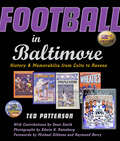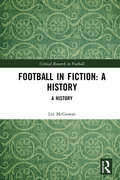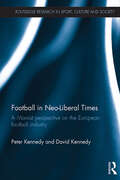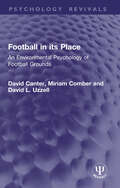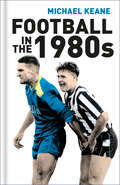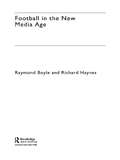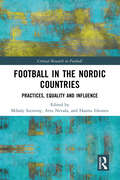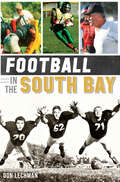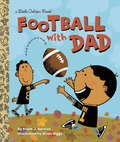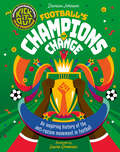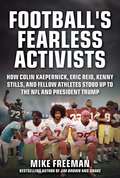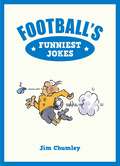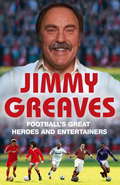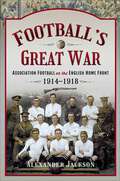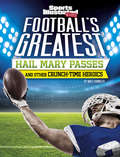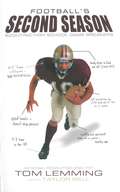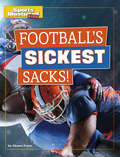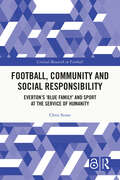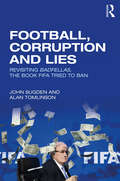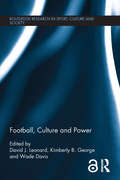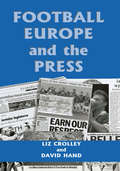- Table View
- List View
Football in Baltimore: History and Memorabilia from Colts to Ravens
by Dean Smith Ted PattersonBaltimore's remarkable football traditions—from the Colts to the Ravens—expressed in sports memorabilia.The second edition of Ted Patterson’s illustrated history of football in Baltimore continues the story of the Ravens' success—from their first Super Bowl victory in 2001 to the emotional parade through downtown Baltimore after winning Super Bowl XLVII. Patterson is joined by Baltimore poet and sports aficionado Dean Smith, whose new chapters capture the energy of Purple Fridays, the larger-than-life personalities of Ray Lewis, Hall of Famer Jonathan Ogden, Jamal Lewis, Matt Stover, Ed Reed, and Joe Flacco, and the city's embrace of the Ravens as a reflection of Baltimore itself. Football in Baltimore is a tour of one of the world's premier collections of Baltimore sports memorabilia—highlighting memorable games and players and exploring a pop culture that surrounded and has survived them. Patterson moved to Baltimore in what turned out to be the final decade of the Baltimore Colts and has amassed a remarkable collection of items that both collectors and sports fans will enjoy.Patterson introduces us to the teams and early stars of Johns Hopkins and Morgan State; Army-Navy games in old Municipal Stadium; high-school rivalries like City-Poly, Loyola–Calvert Hall, Gilman-McDonogh, and the great years of Patterson High; the original Colts (colors silver and green); and, at considerable length, the legendary Baltimore Colts of Johnny Unitas, Lenny Moore, Raymond Berry, Alan "the Horse" Ameche, Artie Donovan, Bert Jones, and Lydell Mitchell. He includes the next chapters in this eventful story: the fight to bring pro football back to the city, the dawn of the Ravens era, and the building of a new football stadium in downtown Baltimore.
Football in Fiction: A History (Critical Research in Football)
by Lee McGowanFootball in Fiction represents the most comprehensive historical mapping and analysis of novels related to association football (soccer). It offers a theoretically informed field guide, a scholarly cartography of football fiction’s uncertain – and until now – only partially explored terrain. Combining an extensive search for texts with up-to-date academic research, journals, surveys, catalogues, and reviews the book demonstrates a topographic perspective of the field – one that captures and establishes its breadth, depth, and distinctive identity. The book uses and adapts two distinct reading models of abstraction, in conjunction with closer textual analyses. Together they assist in realising a set of demonstrable conventions, outline a taxonomy of fictive types, establish the genre’s current state of play, and advance the football novel as a form with its own literary history and traditions. This book is a valuable resource for those studying and researching in the areas of the social and cultural aspects of football, sports fiction, sports writing, creative writing, and literary and genre studies. Furthermore, related industry professionals will find this a fascinating read, particularly football writers, fans of the sport, and those interested in sports history and cultural phenomena.
Football in Neo-Liberal Times: A Marxist Perspective on the European Football Industry (Routledge Research in Sport, Culture and Society)
by Peter Kennedy David KennedyThis book offers an original Marxist critique of the European football business. It argues that the Marxist account of the difference between profits and surplus value is crucial to an understanding of the fluid and contradictory nature of the commodification of football. Section one analyses the nature of modern professional football and section two highlights attempts, via government agency and football clubs, to corral fans into ever greater identification with business logic aimed at breaking traditional social relations. Section three draws on a number of cases studies across Europe, to analyse how some fans are attempting to mount a counter ideological response to the assault of neo-liberalism on the game.
Football in its Place: An Environmental Psychology of Football Grounds (Psychology Revivals)
by David Canter David L. Uzzell Miriam ComberIn the late 1980s football was in a state of crisis. Falling attendances and a genuine unease among potential spectators about going to live football matches suggested that, without radical changes, the game would soon become a minority spectator sport. Originally published in 1989, reissued now with a new preface, Football in its Place presented a new approach to the problem that concentrates on the spectators’ experience of football and on the places where it is played.This approach recognizes four themes, which relate directly to the spectators’ experience: spectator comfort; the need for effective crowd control; the problems of coping in emergencies; and variations in club cultures. A special chapter on football-related violence shows how this needs to be understood in relation to all of these themes and not treated as a problem in isolation. This was said to be the only way to reverse the spiral that had given rise to hooliganism.Finally, the authors discuss the options for the future on football. They emphasize that football is a recreational activity whose management should be treated as part of the leisure industry. All aspects of the game, its traditions, club variations and heritage, needed to be harnessed if football was again to be Britain’s most popular spectator sport. Today we can see the impact that the points made in this book have contributed to how we continue to watch and enjoy football now.
Football in the 1980s
by Michael KeaneDo you remember a time when footballers’ perms were tighter than their shorts? When supporters still swayed on terraces? When a chain-smoking doctor played central midfield for Brazil? Take a nostalgic stroll back to an era when football on TV was still an occasional treat, when almost anyone could finish runners-up to Liverpool and when finishing fourth in the top flight was not a cause for celebration but a sackable offence! Football in the 1980s is an affectionate look at all the essential facts, stats and anecdotes from the decade before the national game was commercially rebranded. Including both some of modern football’s darkest days and its most memorable matches, Football in the 1980s will take you back to a time of tough tackles, muddy pitches and cheap seats. Read on for a grandstand view . . .
Football in the New Media Age
by Richard Haynes Raymond BoyleFootball in the New Media Age analyzes the impact of media change on the football industry, drawing on extensive interviews with key people in the media and football industry. It examines the finances of the game; the rising importance of rights and rights management in the industry; and attempts by clubs to develop their own media capacity. At the core of the book is an examination of the battle for control of the game as media, business and fans all seek to redefine the sport in the twenty-first century. Football is rarely out of the headlines, with stories about star players misbehaving, clubs facing financial meltdown, or TV companies battling over broadcast rights dominating much of the mainstream news and current affairs agenda.The impact of the vast amounts of money paid to elite footballers, and the inability of young men to cope with this when combined with their media-fuelled celebrity status, have frequently made headlines. At the core of this process is the battle to control a game that has exploited its position as a key 'content provider' for new media over the last decade, and this book provides the examiniation and analysis to study this problem.
Football in the Nordic Countries: Practices, Equality and Influence (Critical Research in Football)
by Mihaly Szerovay Arto Nevala Hannu ItkonenThis book explores football culture, organisation and development in the five Nordic countries: Denmark, Finland, Iceland, Sweden and Norway. These countries represent an important case study in sport culture, policy and management, being shaped by unique traditions in their civil society and in social welfare and public policy. The first part of the book explores the development path of football in each country, looking at how football arrived in Scandinavia and how it has been transformed from a voluntary civic activity into a professional sport while becoming closely attached to the global football system. The second part highlights key issues – including historical, contemporary and critical aspects – across three themes: professionalisation and changing practices; equality and gender; and supporters, audiences and culture. Written by a team of authors with a blend of experience as academics and practitioners in football, the book traces the contours of the distinctive Nordic model that occupies a prominent position in the global football system. Shining fascinating new light on the relationship between football and wider society, this is invaluable reading for students and researchers interested in football, sport management, sport policy, or the history, culture or sociology of sport and for anyone involved in the game.
Football in the South Bay
by Don LechmanHardly a season passes in which one or more South Bay football stars don't shine in major college or NFL play. Vince Ferragamo led the Rams to a Super Bowl, but in Wilmington, he's the pride of Banning High School. Before he was television's "Hunter" or an NFL All-Pro, Fred Dryer was an El Camino College and Lawndale High star. Wesley Walker snagged deep passes for the New York Jets but honed his skills under legendary coach Gene Vollnogle for the Carson High Colts, historically the top prep team in the South Bay. From the inspirational coaches like Mira Costa's Don Morrow and San Pedro's Mike Walsh to the greatest players raised here, author Don Lechman presents the full story of South Bay gridiron glory.
Football with Dad (Little Golden Book)
by Brian Biggs Frank BerriosEvery Sunday, a boy and his dad watch the big football game on TV, and then go outside to play it. In this simple introduction to the game, the emphasis is on playing safely and having fun.From the Hardcover edition.
Football's Champions of Change
by Damian JohnsonThis inspirational book charts the history of the anti-racism movement in English football and beyond, shining a light on both the divisive and unifying power of the beautiful game.Discover the star footballers, which include the likes of Arthur Wharton, Walter Tull and Clyde Best from the early days, to the modern greats such as Raheem Sterling, Marcus Rashford and Bukayo Saka who have faced and fought racial bigotry on the pitch and helped advance the cause. There are also commentaries and insights from coaches, referees as well as grassroots activists who are prominent voices in the mainstream andsocial media. Features inspiring vox pops from young, modern-day aspiring players and fans from different ethnic backgrounds, explaining their experiences and their own battle (and triumphs) to be treated equally on the pitch and in society.
Football's Fearless Activists: How Colin Kaepernick, Eric Reid, Kenny Stills, and Fellow Athletes Stood Up to the NFL and President Trump
by Mike FreemanFor the first time, here is the full story of the NFL player protests that rocked a nation and turned our country upside down. This is the players' side, one that has largely been ignored by the media.On September 1, 2016, Colin Kaepernick took a knee before a preseason game. Little did he, nor anyone else, know the ramifications from that decision. Since being exiled from the National Football League, Kaepernick has stood strong against all those who have attacked him. He and others who took a knee against racial inequality and police brutality have been ridiculed, mocked, threatened, and some have even lost their jobs. They have feared for their safety and that of their loved ones. But what made Kaepernick kneel, and the entire country turn a silent protest into a national pandemic? One person: President Donald Trump. For the first time, veteran journalist Mike Freeman sits down with those directly involved in the protests—the players—to find out how things really went down. Readers will learn why they decided to protest, how racism and the murdering of innocent men of color directly affected them, how the politics of protest affected their professional and personal lives, and if anything has even changed for the better. Including interviews with Colin Kaepernick, Eric Reid, Kenny Stills, Michael Bennett, Richard Sherman, and numerous others, see first-hand how the media, President Trump, and the National Football League took a peaceful message for change and turned it on its head. They changed the narrative, accusing these men of being &“anti-America,&” &“anti-military,&” and &“disrespecting the flag.&” In Football&’s Fearless Activists, Freeman offers an opportunity to understand what these protests meant to the players, and how the hatred from the media, President, NFL owners, and some Americans was not only unwarranted, but anti-American.
Football's Funniest Jokes (Funniest Ser.)
by Jim ChumleyWhat did the manager do when the pitch became flooded? He sent on his subs. Football is a funny old game, and not only because of the players’ hairstyles. Football’s Funniest Jokes is guaranteed to raise a chuckle even if you’re still feeling sore about that goal that was NEVER off-side.
Football's Funniest Jokes (Funniest Ser.)
by Jim ChumleyWhat did the manager do when the pitch became flooded? He sent on his subs. Football is a funny old game, and not only because of the players’ hairstyles. Football’s Funniest Jokes is guaranteed to raise a chuckle even if you’re still feeling sore about that goal that was NEVER off-side.
Football's Great Heroes and Entertainers: The History of Football through its biggest heroes
by Jimmy GreavesJIMMY GREAVES was a great entertainer and a national hero as a footballer, and is held in equal affection as a television pundit and performer. Now Greavsie reveals the footballers and managers who have given him most entertainment and are his biggest heroes. Greavsie has confined his star-studded assembly to players and managers of his lifetime -- dipping fondly back into the days of Stanley Matthews, Tom Finney and Len Shackleton and coming up to date with in-depth analysis of modern masters like Thierry Henry, Steven Gerrard and Wayne Rooney. Along the way he nods in the direction of his good pals Bobby Moore, Dave Mackay, Billy Wright and, of course, George Best. Footballing gods of the calibre of Pele, di Stefano, Puskas and Maradona naturally win a place in the personal Greaves Hall of Fame. You may not agree with all his selections, but if you are a true football fan you will agree that this is a book that makes you laugh and grips your attention as you take a look at some of FOOTBALL's GREAT HEROES AND ENTERTAINERS.
Football's Great Heroes and Entertainers: The History of Football through its biggest heroes
by Jimmy GreavesJIMMY GREAVES was a great entertainer and a national hero as a footballer, and is held in equal affection as a television pundit and performer. Now Greavsie reveals the footballers and managers who have given him most entertainment and are his biggest heroes. Greavsie has confined his star-studded assembly to players and managers of his lifetime -- dipping fondly back into the days of Stanley Matthews, Tom Finney and Len Shackleton and coming up to date with in-depth analysis of modern masters like Thierry Henry, Steven Gerrard and Wayne Rooney. Along the way he nods in the direction of his good pals Bobby Moore, Dave Mackay, Billy Wright and, of course, George Best. Footballing gods of the calibre of Pele, di Stefano, Puskas and Maradona naturally win a place in the personal Greaves Hall of Fame. You may not agree with all his selections, but if you are a true football fan you will agree that this is a book that makes you laugh and grips your attention as you take a look at some of FOOTBALL's GREAT HEROES AND ENTERTAINERS.
Football's Great War: Association Football on the English Home Front, 1914–1918
by Alexander JacksonAs modern football grapples with the implications of a global crisis, this book looks at first in the game’s history: The First World War. The game’s structure and fabric faced existential challenges as fundamental questions were asked about its place and value in English society. This study explores how conflict reshaped the People’s Game on the English Home Front. The wartime seasons saw football's entire commercial model challenged and questioned. In 1915, the FA banned the payment of players, reopening a decades-old dispute between the game's early amateur values and its modern links to the world of capital and lucrative entertainment. Wartime football forced supporters to consider whether the game should continue, and if so, in what form? Using an array of previously unused sources and images, this book explores how players, administrators and fans grappled with these questions as daily life was continually reshaped by the demands of total war. From grassroots to elite football, players to spectators, gambling to charity work, this study examines the social, economic and cultural impact of what became Football's Great War.
Football's Greatest Hail Mary Passes and Other Crunch-Time Heroics (Sports Illustrated Kids Crunch Time)
by Matt ChandlerWhen time is running short and the Lombardi Trophy is at stake, some players seize the moment and make themselves legends. From Hail Mary passes to tackle-breaking touchdown runs, some of football's greatest moments are chronicled in vivid fashion here. You've got sideline pass to the action.
Football's Second Season: Scouting High School Game Breakers
by Tom LemmingNational recruiting analyst Tom Lemming has become one of the most influential and controversial names in the recruiting business. This book chronicles Lemming's recruiting journey and his passion for the process, which has turned into its own sport. He discusses everything you need to know about college recruiting, as well as what coaches look for when evaluating prospective recruits. College and high school football fans will benefit from the insight into Lemming's profession.
Football's Sickest Sacks! (Sports Illustrated Kids Prime Time Plays)
by Shawn PryorHike! When the center snaps the ball, the defensive line pounces, and it’s prime time on the gridiron. From bone-rattling hits to game-changing take-downs, experience the sickest sacks from football’s biggest superstars. These tremendous quarterback-crunching plays will leave you stunned!
Football, Community and Social Responsibility: Everton’s ‘Blue Family’ and Sport at the Service of Humanity (Critical Research in Football)
by Chris StoneThis book shines a light on the value and effectiveness of football clubs’ community engagement work, the cultural value of sport and the position sport plays within people’s daily lives.The book considers the deep historical roots that many football clubs have as charitable institutions within their civic locales. Including original research carried out during the COVID-19 pandemic, the book presents an in-depth case study of Everton FC and their associated charitable trust. It takes a close look at the outreach work that they undertook during the pandemic to support vulnerable people in the local community and considers the value of that work more generally for local residents, football fans, club staff and other stakeholders. The book also places the Everton case study in the context of wider debates around the use of sport in the service of humanity, and corporate social responsibility in the sport industry.This is fascinating reading for any student, researcher, policy maker, practitioner or football fan with an interest in sport (for) development, community work, the relationship between sport consumption and wider society, ethical business or the English Premier League.
Football, Community and Sustainability (Sport in the Global Society – Contemporary Perspectives)
by Chris Porter Anthony May Annabel KiernanA lack of ‘sustainability thinking’ is evident at the heart of many of the problems that football faces today; from the huge amounts of money that clubs seem compelled to spend on what are often short-term gains – and the speculation, debt and market-centred ideology that goes with it – to the not unrelated deep disenchantment experienced by many football fans for a game that they still, despite it all, remain determined to love.Sustainability here is more broadly conceptualised than focusing on environmental issues. It encompasses social and economic sustainability, albeit with a critical eye on the interdependent, often contradictory, relationship between what the United Nations regards as the three ‘pillars’ of sustainability (environmental, social and economic). Fittingly, this book is the result of an international collaboration between an interdisciplinary network of academics and football industry practitioners, brought together by the Centre for the Study of Football and its Communities (CSFC), based at Manchester Metropolitan University, UK. The critical insights collected here focus not just on football’s problems, but also how clubs, authorities, players and fans in a range of local contexts are positively tackling the challenges of surviving and thriving in the contemporary global game. This book was originally published as a special issue of Sport & Society.
Football, Corruption and Lies: Revisiting 'Badfellas', the book FIFA tried to ban
by Alan Tomlinson John SugdenWorld football is in crisis. The corruption scandal engulfing FIFA is arguably the biggest story in the history of modern sport and a watershed for sport governance. More than a decade ago, John Sugden and Alan Tomlinson laid the foundations for subsequent investigations with the publication of Badfellas, a groundbreaking work of critical sport sociology that exposed the systematic corruption at the heart of world football. It was a book that FIFA and Sepp Blatter tried to ban. Now re-issued to combine the original contents of Badfellas with new chapters covering the current crisis, this book points to the ways in which FIFA’s new administration can learn from the Blatter story. The prequel traces the course of Sugden and Tomlinson’s game-changing investigation into FIFA, while the sequel updates the FIFA story from 2002 onwards and provides a chronology of crises and scandals within the FIFA narrative. Demonstrating the vital importance of critical investigative methods in sport studies, Football, Corruption and Lies: Revisiting Badfellas, the book FIFA tried to ban is essential reading for anybody looking to understand Blatter’s rise and fall.
Football, Culture and Power (Routledge Research in Sport, Culture and Society)
by Wade Davis David J. Leonard Kimberly B. GeorgeWhat does it mean when a hit that knocks an American football player unconscious is cheered by spectators? What are the consequences of such violence for the participants of this sport and for the entertainment culture in which it exists? This book brings together scholars and sport commentators to examine the relationship between American football, violence and the larger relations of power within contemporary society. From high school and college to the NFL, Football, Culture, and Power analyses the social, political and cultural imprint of America’s national pastime. The NFL’s participation in and production of hegemonic masculinity, alongside its practices of racism, sexism, heterosexism and ableism, provokes us to think deeply about the historical and contemporary systems of violence we are invested in and entertained by. This social scientific analysis of American football considers both the positive and negative power of the game, generating discussion and calling for accountability. It is fascinating reading for all students and scholars of sports studies with an interest in American football and the wider social impact of sport. Chapter 14 of this book is freely available as a downloadable Open Access PDF at http://www.taylorfrancis.com under a Creative Commons Attribution-Non Commercial-No Derivatives (CC-BY-NC-ND) 4.0 license.
Football, Europe and the Press (Sport in the Global Society #No. 24)
by Liz Crolley David HandThis book examines the construction of national, regional, and group identities in the football journalism of five European countries: England, France, Germany, Italy and Spain. Notions of the respective national stereotypes are explored in each of the countries studied.
Football, Family, Gender and Identity: The Football Self (Critical Research in Football)
by Hanya PielichatyThis book presents a cross-disciplinary examination of the lived experiences of girls and women football players using theoretical insights from sports studies, psychology, sociology and gender studies. It examines the concept of ‘the football self’ – your own, personal football identity that encapsulates the importance of football to our everyday lives – and what that can tell us about the complex relationships between sport, family, gender and identity. The book draws on in-depth ethnographic research involving players and family members, and offers important new insights into the everyday experiences of those girls and women who play. It breaks new ground in focusing on the significant relationships between player and family with a particular focus on parenting through football. The book brings to the fore key debates around gender identity, barriers to participation, cultural gaps and discrimination. The author also brings a personal perspective to bear, drawing on experience gained over 20 years as a player, adding an extra critical layer to her important empirical research. This is essential reading for all researchers and students with an interest in football, sport studies or issues around gender, inclusion or the family in sport, and fascinating reading for anybody generally curious about football.
